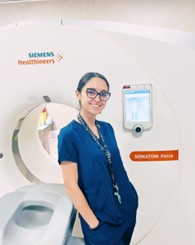Artificial intelligence in magnetic resonance imaging for predicting lymph node metastasis in rectal cancer patients: a meta-analysis Zhiqiang Bai1 , Lumin Xu1 , Zujun Ding2 , Yi Cao1 , Zepeng Wang1 , Wenjie Yang3 , Wei Xu3 and Hang Li1.
Rectal cancer, which accounts for approximately 30–35% of colorectal cancer cases, is among the most prevalent malignancies worldwide. Lymph node metastasis plays a critical role in disease progression and is closely linked to poor prognosis. Therefore, accurate preoperative detection of LNM is essential for guiding surgical planning and personalized treatment, as emphasized by clinical guidelines. AI models, particularly deep learning algorithms, may offer added value in lymph node assessment by potentially overcoming some limitations of MRI in distinguishing benign from malignant nodes. A comprehensive literature search was conducted between September and November 2024 across PubMed, Embase, and Web of Science, using strict selection criteria to identify a substantial number of suitable studies. The risk of bias in the included studies was assessed using the Quality Assessment of Diagnostic Accuracy Studies tool (QUADAS-2). Heterogeneity was quantified using the I² statistic, and potential sources of heterogeneity were explored through subgroup and meta-regression analyses. For the quantitative analysis of MRI-based AI in preoperative LNM detection, 16 studies were included. The pooled sensitivity and specificity were both 0.71 (95% CI: 0.66–0.74 and 0.67–0.75, respectively), with an area under the curve (AUC) of 0.77. Specificity showed high heterogeneity (I² = 67%), primarily influenced by internal validation sample size, study design, MRI sequence, and lymph node location. For the analysis of radiologists’ performance, five studies were included. The pooled sensitivity was 0.64 (95% CI: 0.49–0.77), and specificity was 0.72 (95% CI: 0.62–0.80), with an AUC of 0.74. This study provides a direct comparison between MRI-based AI models and radiologists, demonstrating AI’s potential to support and possibly enhance diagnostic accuracy. It suggests a feasible path for clinical implementation using conventional MRI data. By pre-screening images, flagging suspicious lymph nodes, and ensuring consistent performance, AI models may help radiologists reduce diagnostic workload and improve efficiency—particularly in resource-limited settings. | However, considerable heterogeneity across the included studies limits the generalizability of the findings, underscoring the need for rigorous external validation to determine clinical applicability. Additionally, a high risk of bias— References 1. Bai, Z., Xu, L., Ding, Z. et al. Artificial intelligence in magnetic resonance imaging for predicting lymph node metastasis in rectal cancer patients: a meta-analysis. Eur Radiol (2025). doi.org/10.1007/s00330-025-11519-y 2. Jin M, Frankel WL (2018) Lymph node metastasis in colorectal cancer. Surg Oncol Clin N Am 27:401–412. doi.org/10.1016/j.soc.2017.11. 011 3. Nagtegaal ID, Knijn N, Hugen N et al (2017) Tumor deposits in colorectal cancer: improving the value of modern staging-a systematic review and meta-analysis. J Clin Oncol 35:1119–1127. doi.org/10.1200/jco. 2016.68.9091 4. Borgheresi A, De Muzio F, Agostini A et al (2022) Lymph nodes evaluation in rectal cancer: where do we stand and future perspective. J Clin Med 11:2599. doi.org/10.3390/jcm11092599 5. Whiting PF, Rutjes AW, Westwood ME et al (2011) QUADAS-2: a revised tool for the quality assessment of diagnostic accuracy studies. Ann Intern Med. doi.org/10.7326/0003-4819-155-8-201110180-00009.
Comments may be sent to: silvia.lippa@uniroma1.it |

